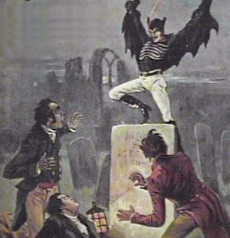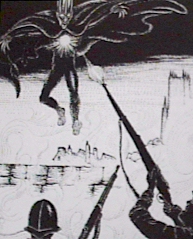 |
 |
Spring-Heeled Jack first leapt out of the shadows in the late fall of 1837.
At first he was just a rumour, and few Londoners believed the tales they
heard of the bogey-man who was reputed to be be able to leap huge hedgerows,
and breathe flames from his mouth. Few believed the tales of the attacks,
mostly on young women, carried out by the mystery man. The rumours
persisted as the number of attacks grew. It seemed his modus opperandi was
to secret himself behind walls or bushes and then leap out on unsuspecting
travellers. Usually he would rip their clothes with the claws on his hands,
and breathe flames into the victims' faces. Then, with shock still
immobilizing his prey, he would bound away in huge, leaping strides which
covered great distances at each step. The thing about the devil-man which
most stuck out in the minds of the victims were his terrible, protruding,
hell-like eyes, and his peculiar ringing laughter, which echoed in their
minds for days afterward. Concerned citizens formed vigilante committees to
try and track down the miscreant, and at one point the group included the
Duke of Wellington, and Admiral Codrington, the former of which set out on
horseback every night with his trusty pistols to try and bring Spring-Heeled
Jack to justice. All to no avail. Spring-Heeled Jack continued his reign
of terror. His ability to leap over huge hedgerows and walls made him
extremely difficult to catch. He had also added the act of terrifying
coach-drivers to his list of conquests. The attacks reached a climax when,
in the winter of 1838, he moved his activities into the city proper.
The first of these London attacks took place on a dark February night. Lucy
Scales was walking home with her sister from their brother's house along a
lonely street in the Limehouse district. As they passed Green Dragon Alley,
a tall cloaked figure bounded out of the shadows at them. He spat blue
flames into Lucy's face, blinding her. As she lay writhing on the ground,
Spring-Heeled Jack calmly turned around and melted back into the shadows.
Panic spread over the city of London. Up until now, the man's activities
had been centred around the surrounding towns and villages along the Thames.
Word spread quickly: Spring-Heeled Jack was on the prowl in London itself!!
He struck again a few nights later. The Alsop family was spending a quiet
evening at home, when a violent knocking was heard at the front door. Jane
Alsop (who lived with her father and her two sisters) got up to answer it.
When she opened the door she saw a man standing in the shadows near the
front gate. He swung around. "I'm a police officer," he said. "For God's
sake, bring me a light, for we have caught Spring-Heeled Jack in the lane!"
As Jane ran to fetch a candle, she thought how exciting it would be to see
Spring-Heeled Jack arrested. When she gave the candle to the man at the
gate, she realized she had made a terrible mistake, for the man applied to
candle to his breast to reveal the hideous features of Spring-Heeled Jack
himself! Jane screamed as he vomited forth a huge amount of flame from his
mouth. He then grabbed her and tore at her clothes with his sharp claws.
She tried to get away, but the man caught her and continued his attack.
Soon the whole family ran out into the street, hearing her screams, but
Spring-Heeled Jack bounded away down the road, and was soon lost to sight.
Jane described her inhuman attacker to the police, saying that he wore a
tight oilskin suit, and a kind of close-fitting helmet on his head (pictures
of Spring-Heeled Jack portray him as wearing a mask with a pointed beard and
pointed ears--like a devil)
Spring-Heeled Jack made an aborted attempt at the same trick a few nights
later at another house, but a servant boy realized who he was and began to
shout for help. Spring-Heeled Jack escaped again, this time victimless.
Throughout the 19th century, Spring-Heeled Jack was sighted all over
England. After a brief period of inactivity in the late 1830's he was seen
 time
and time again in the 1840's and 50's.
time
and time again in the 1840's and 50's.
He frightened army sentries in the 1870's, by
darting out of the darkness and slapping their
faces with a cold, clammy hand before leaping
onto the roofs of their sentry boxes. Angry townspeople
shot at him in the streets on night in 1877. As usual, he
laughed and melted away into the darkness,
unrepentant.
Spring-Heeled Jack was last seen in 1904 in Liverpool.
There, he terrified people by bounding up and down the streets and onto their rooftops.
When attempts were made to corner him, but simply vanished into the darkness.
This was the last reported sighting of Spring-Heeled Jack.
It is thought that the original Spring-Heeled Jack (for there was obviously
more than one) was an Irish nobleman, The Marquis of Waterford, who was
renowned for his sadistic taste in practical jokes, and his scorn for women.
Author Peter Haining in his book "The Legend and Bizarre Crimes of
Spring-Heeled Jack" believes that Waterford's idea for the character of Jack
was brought about by a humiliating experience with a woman and a police
officer while travelling abroad. Haining believes that Waterford and his
rich friends thought up the idea as a prank to get even, by proxy, with the
police and women in general. Haining also believes that Waterford (who had
friends who studied applied mechanics) helped him invent "spring-heeled
boots" (boots with powerful springs in the heels) to help him with his
attacks. It is likely that he also learned the technique of the fire-eater
in order to heighten the supernatural aura of Spring-Heeled Jack. In
addition, Waterford had strangely protuberent eyes, which matched the
descriptions of Jack. He was also in the area when many of the attacks
occured. As a final piece of evidence, the servant boy who scared Jack away
saw a crest with the letter "W" on the man's cloak.
Although the mystery of Spring-Heeled Jack's identity has probably been
ascertained, it is far more entertaining and romantic to think of
Spring-Heeled Jack as a mysterious creature of the night who may someday
leap from the shadows again.
By Mark Brodie